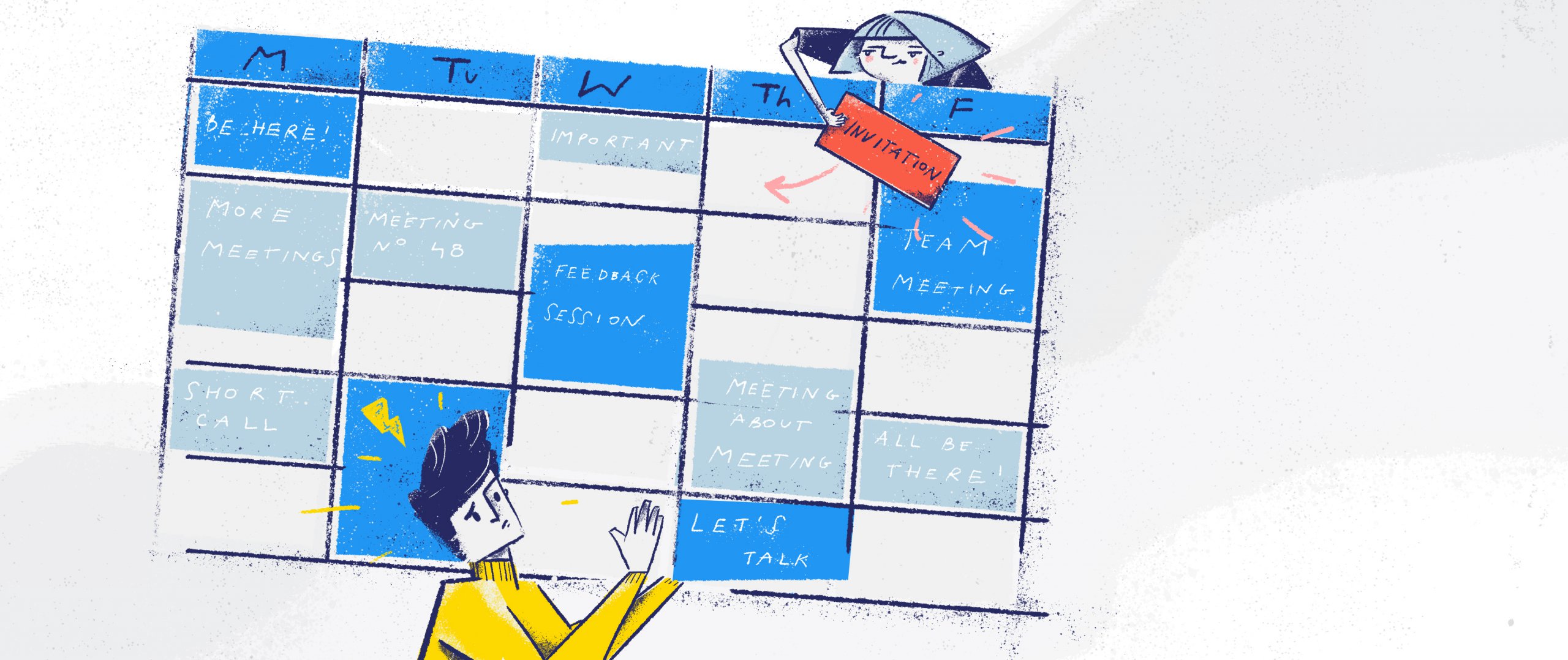
How many meetings have you had this week? How many of them gave you or your organization real value? Did they resolve any problems? Did you know why you were there? Have you ever thought during the meeting: ‘Gosh..when the hell will it be over’? I know I have! At Tooploox we need to communicate efficiently because many of us work remotely and it’s way harder to facilitate a meeting with your distributed team, so we are constantly working on how to improve them. In this blog post, you can find some hints and common mistakes people make. You don’t run meetings? Well, how about checking out if your team makes some of them.
First rule: Preparation is the key…
…a big, forgotten, rusted, put-into-the-junk-drawer key.
Do you know that for many good facilitators preparing a meeting takes 2-4 times longer the meeting itself? Don’t you believe we need this time? Let’s see how most of the meeting invitations look like.
1. Invitation from Hell
No Agenda Or Purpose
Strong agenda will help you stay on track. It will inform attendees about a goal of the meetings and subjects to be discussed. Especially, when you expect people to come prepared, you should include some meeting materials (but don’t expect all of them to read them). Do you have some weekly meetings? Remember to mention the purpose of the meeting in the description and write a new agenda each time.
To create a useful, actionable agenda you can try to answer these questions:
- What is the purpose of the meeting?
- What deliverables(outcomes) do we need to have to achieve this goal?
- What are the questions that lead to these outcomes?
- In what order should we achieve the outcomes?
- What approach/technique should we use?
- How much time do we need?
- Can these outcomes be produced to meet the purpose in a given time?
And remember not to overcrowd your agenda, especially if you are an inexperienced facilitator as you may easily run out of time. To sum up, a well-planned agenda leads to a clear purpose and creates space for open discussion and disagreement. Attendees should know the desired outcomes of the meeting they are invited to.
Everybody Is Invited
Big all hands/all teams meetings are usually boring, especially when only a few people have a business they want to discuss. Because don’t want to leave anybody out, we invite everyone and they feel obligated to join our call. Instead, next time ask yourself ‘Who do I truly need to attend this discussion?’ and ‘Who can be just informed about the results?’ – and set the invitation as ‘optional’ accordingly.
Many times we want feedback from everybody. And that’s fine, but you can do it offline. In my project, for example, we like Confluence. We can create decision logs and add our conclusions from the meeting for others to comment on. It’s sufficient and people can do it once they have time.

We Don’t Check Availability Of The Others
Personally, I feel confused and little insulted whenever I get an invite and clearly have something on my calendar at that time. It has something to do with what I mentioned earlier. Seeing a long list of attendees in the invitation makes me treat it as lower priority meeting.
For some hints about how to check availability read: Effective google calendar
You Send Invitation To Fit In The Last Free Slot In The Calendar That Day
Ok, this one is right in theory but just put yourself in his/her shoes. Imagine Linda, who has meetings all day long. She has one slot left on the calendar. She figures she might have some lunch then (or catch up with e-mails/work) and…bang! Here comes the invitation. Can you feel the frustration? Yes, sometimes there is no other option. But most of the times you can simply ask if adding anything to their calendar is going to hurt a lot.
2. Meeting facilitation
Be Prepared
OK, so you have an awesome agenda, you sent a proper invitation to the right people, what else can you do? Well, remember about the environment. If you have face-to-face meeting, be there 10 minutes earlier to prepare the room, arrange the tables, air the room, put some pens and sticky notes for the participants. I really like handmade flipcharts to add some visual facilitation to the meeting.
If you work in a remote world like me, be wise when choosing the tools. Not all of them will help you to collaborate with the audience. You should know their limits. We usually use Google Hangouts or Apear.in for calls and Confluence or Dropbox Paper for collaboration.
Create Your Meeting Etiquette
It’s a good idea to set some ground rules before you get started. Meeting agreements will help you enforce desired behaviors. They can be basic e.g. about participation, confidentiality, timeboxes, laptops/phones, respect, breaks, etc.
Time Is Of The Essence, Use It Wisely
Starting on time vs latecomers
Needless to say, meetings should start on time, but it can be challenging when somebody is late. In general, it’s okay to wait a few minutes but I’ve learned that when you have meetings with the same group of people, you will create a meeting culture, so you can as well always start on time and never wait for latecomers, even if they are “in charge”. This way, you show respect to those who are on time and others will learn not to be late for your meetings. Some teams have rules for latecomers, e.g. if you late, you take notes etc. Doing so is a bit sneaky but apparently, it works for them.
Why is it important? Wouldn’t it be better to wait some more time for the important participant? Well, 2-5 min is fine, but when people are waiting for others they may leave the room to make coffee and you end up starting a meeting 10-15 minutes late.
The same rule applies to coming back from the break, especially during a long training/workshop. Just close the door and start on time even if nobody is in the room. As insane as you might feel doing it, people usually will be on time after the next break.
Timeboxing
You should constantly monitor the time and always finish meetings on time. When you do exercises or let people discuss something inside groups, let them know how much time they have, so they are not surprised when you call them. It’s good to have some timer that everybody can see.
Of course, sometimes life will throw you a curveball so when you see the goal of the meeting won’t be met, you have 2 options. You can ask participants if they want to stay longer (but you should declare how long) or you could wrap up the task and decide together, using the last minutes, what to do now. Perhaps you need a follow-up meeting or you can do the rest asynchronously using any form of a document.
Use Your Agenda
Decision Making Process
Meetings with agendas are more effective and results-oriented. The agenda will guide you and keep everybody focused on the topic. Remember to identify timeboxed actions and the owners for each topic before you move on to the next one. As for the recurring meetings, it’s always a good idea to check the status of the Action Items established during the previous meeting and see what has been completed so far.
Don’t forget about the goal
At the beginning of the meeting declare its purpose, which answers a simple question: Why are we here? You can write it down. At the end, go back to the goal you wrote and check if you achieved it. It can also serve as a reminder and if the conversation goes off track, ‘park’ it and move on. Don’t be afraid to stop important, yet off-topic discussions. Whenever you do so, write down the suspended topics, revisit them at the end of the meeting and mention in the final notes.
3. The icing on the cake
Clean Up After Yourself
You should always clean the room after the meeting, especially when people were drinking or eating. Even if you expected the attendees to clean after themselves, there will always be some forgotten glass or maybe extra chairs that should be returned.
Keep A Record
That’s not the end of your work. Now you have more or less one day to send everybody the meeting notes with action items, any agreements and decisions made and list of all the topics you parked. Most of us are not Sheldon Coopers and we don’t have the eidetic memory so it’s better to keep important stuff written down.





